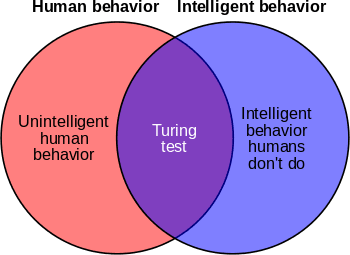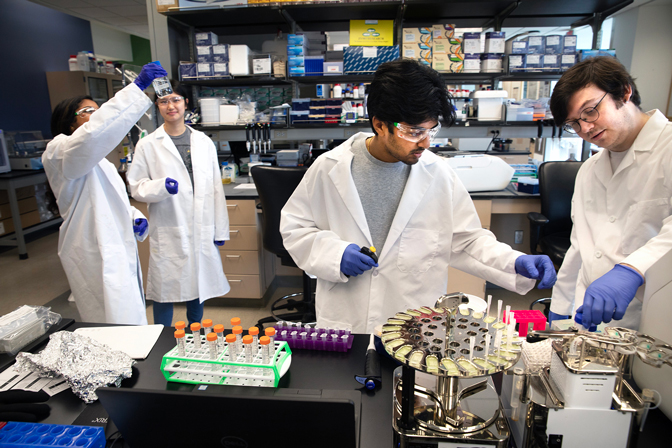
Researcher develops test to assess a computer’s capacity for human-level intelligence through its ability to create rather than to converse or deceive
A Georgia Tech professor recently offered an alternative to the celebrated “Turing Test” to determine whether a machine or computer program exhibits human-level intelligence. The Turing Test – originally called the Imitation Game – was proposed by computing pioneer Alan Turing in 1950. In practice, some applications of the test require a machine to engage in dialogue and convince a human judge that it is an actual person.
Creating certain types of art also requires intelligence observed Mark Riedl, an associate professor in the School of Interactive Computing at Georgia Tech, prompting him to consider if that might lead to a better gauge of whether a machine can replicate human thought.
“It’s important to note that Turing never meant for his test to be the official benchmark as to whether a machine or computer program can actually think like a human,” Riedl said. “And yet it has, and it has proven to be a weak measure because it relies on deception. This proposal suggests that a better measure would be a test that asks an artificial agent to create an artifact requiring a wide range of human-level intelligent capabilities.”
To that end, Riedl has created the Lovelace 2.0 Test of Artificial Creativity and Intelligence.
For the test, the artificial agent passes if it develops a creative artifact from a subset of artistic genres deemed to require human-level intelligence and the artifact meets certain creative constraints given by a human evaluator. Further, the human evaluator must determine that the object is a valid representative of the creative subset and that it meets the criteria. The created artifact needs only meet these criteria but does not need to have any aesthetic value. Finally, a human referee must determine that the combination of the subset and criteria is not an impossible standard.
The Latest on: Artificial intelligence
[google_news title=”” keyword=”Artificial intelligence” num_posts=”10″ blurb_length=”0″ show_thumb=”left”]
via Google News
The Latest on: Artificial intelligence
- Guest Perspective: How does Artificial Intelligence impact inventorship? US Patent and Trademark Office issues new guidelines.on May 8, 2024 at 1:45 pm
In 2022, the Federal Circuit ruled that an inventor had to be a natural person. While this decision only relates to a sole AI inventor, its reasoning could easily be applied to a joint inventor. As ...
- The idea factory in artificial intelligenceon May 8, 2024 at 12:26 pm
Ideas “are different from nearly all other goods in economics,” said Charles Jones of the Stanford Institute for Economic Policy Research at a symposium last year. Unlike material goods or workers, ...
- 1 Artificial Intelligence (AI) Stock Down 29% to Buy Right Now Before It Soars 78%on May 8, 2024 at 7:30 am
This chip stock tanked following the release of the company's latest earnings report, but investors shouldn't miss the bigger picture.
- Artificial Intelligence And Human Expertise In Graphic Designon May 8, 2024 at 4:15 am
Technology has long been a key part of graphic design, but modern AI-powered tools are going beyond traditional tools by leaps and bounds.
- 2 Red-Hot Artificial Intelligence (AI) Stocks to Buy Before They Soar 81% and 83%, According to Certain Wall Street Analystson May 8, 2024 at 1:45 am
Red-hot artificial intelligence (AI) stocks Super Micro Computer and SoundHound AI soared 506% and 96%, respectively, during the past year. Super Micro Computer is a leading manufacturer of AI servers ...
- Artificial Intelligence Could Help Officers Screen Applicants for Asylum at Borderon May 7, 2024 at 11:05 pm
The Department of Homeland Security is piloting artificial intelligence to train officers who review applicants for refugee status in the United States, Secretary Alejandro Mayorkas told reporters on ...
- JAMS Issues Rules Governing Disputes Involving Artificial Intelligence Systemson May 7, 2024 at 5:00 pm
Staying up-to-date with these changes has become as fundamental to litigation as other procedural rules. The Artificial Intelligence Group at Ballard Spahr monitors developments in AI and is advising ...
- Exploring the Issues and Implications of Artificial Intelligenceon May 7, 2024 at 5:00 pm
Holland & Knight recently teamed with Florida State University College of Law to host an Artificial Intelligence (AI) Summit at the firm's Washington, D.C., office. Using panel-style discussions, the ...
- 12 Best Artificial Intelligence Stocks to Buy Now According to Wall Street Analystson May 7, 2024 at 4:40 pm
In this piece, we will take a look at the 12 best artificial intelligence stocks to buy now according to Wall Street analysts. If you want to skip our coverage of the latest developments in the ...
- A university creates an artificial intelligence institute, partly to help governmenton May 7, 2024 at 3:06 pm
The University of Maryland has launched of a new institute dedicated to developing the next generation of artificial intelligence people.
via Bing News










